Genre: Hack-‘n-Slash Developer: Taito Publisher: Taito Players: 1 Released: 1988
You know, despite how cheesy the 1982 movie was, Conan The Barbarian inspired a lot of different mediums when it was released. Sure, the Conan stories had been around since the 1930s, but when the movie hit, artists created all sorts of characters and stories that tried to draw in fans of that depiction of the muscle-bound barbarian. Even video games found inspiration from the movie’s popularity, though not all of them came out right away. The classic Golden Axe from 1988 was given life by SEGA, and that game even used a handful of voice samples from the movie. However, Rastan by Taito hit the scene in 1987, entertaining gamers with its nice graphics, impressive soundtrack, and straight-forward gameplay. The following year, the Taito classic jumped from the arcade and landed on the NES’ 8-bit rival on the video game console home front, the SEGA Master System. But did it stick the landing, or did it do a face plant on the mat? Read on.
As a bounty hunter by trade, you’ve made a reputation for yourself. The battles you’ve fought are shown by the scars your body carries, and those around you know that when you arrive, bloodshed is not far behind. And though you’ve carved out your own path in the world, the world isn’t done forcing its hand upon you. A king has come to you, requesting that you save his daughter. She’s been taken to the horrid land of Semia, a place so feared, that even the vilest are wary to set foot there. But you’ve been promised riches that most could only dream of… if you go. But there is no “if” on the edge of your sharpened sword. There’s only the blood of those who have tried to keep you from making your own destiny. And that sword will once again spill blood as you set out to bring the princess back and collect what was promised you.
When it comes to its graphics, Rastan isn’t going to win any awards for the Master System. On the one hand, a fair number of the sprites for the characters look reasonably good. Rastan himself, the chimera, some of the bosses… they look nice and the color usage is pretty solid, even if it is a bit minimal for the system. Other times, the sprites seem more like an odd mess of color (like the stage 1 harpies, or the recolorings of some enemies on the later stages) or weren’t redesigned very well for their shrunken versions (like the lizard men, bats, or the half-armored guards). The sprite animations are the same way. Some, like Rastan swinging his sword, the chimera walking, or the wings of the harpies, have several frames and look fine overall. Others, like the walking cycle for many ground enemies, are two frames and look choppier as a result. Granted, the arcade game wasn’t an animation powerhouse, but its basic level of animation was still trimmed even further for the SMS port.
The backgrounds are good and bad in a somewhat similar fashion. On the one hand, there’s a variety of stages, from mountains and swamps, to castles and caves. You’ll encounter animated fire/lava and waterfalls, swinging vines, and other environmental touches that, as a whole, help the stages not look too bad. They also do a decent job in terms of details with the rock patterns and such. But at times, the stages stumble in their visual splendor. Stage two’s swamp for example, looks less than impressive with some odd color choices for the shading on the tree trunks behind everything. These areas don’t crop up too often, but they’re noticeable when they do. So while this game isn’t really a showcase for what the Master System can do visually, it’s still a decent looking game when it’s all added up.
In the sound department, Rastan does a pretty good job. With the music, it tries its best to capture the orchestral nature of the adventurous-sounding original arcade soundtrack. While it’s obviously downgraded due to the SMS’ weaker sound chip, the music for the outdoor stages still sets the mood fairly well, giving you a fitting rhythm to explore and fight to. In the castles, the music takes a slightly eerier tone as you make your way past the traps, pits and enemies scattered about. And when you reach a boss, the music gets more tense to mirror the confrontation. There aren’t many songs, as the same three are used throughout all of the game’s stages (just like the arcade), but they’re fitting and decent conversions of the arcade originals. With the sound effects, you get what you’d expect. Enemy death bursts, sword swinging hisses, landing on the ground static bursts, item pick up pings… nothing that goes beyond what’s needed, or excels quality-wise. They work without being horrid or unpleasant, and that’s about all there is to them. As such, the sound in the game does a fairly respectable job overall.
With the gameplay, there are a few things to keep in mind. While Rastan is a port of an arcade game, it’s also an altered port. Like the arcade, you can swing your sword, thrust it downward, or stab up at airborne enemies. You’ll jump over pits, swing from vines to get over spikes/lava/water, float on rafts to cross the water, and dodge a boulder or two that gets in your way. More powerful weapons like a battle axe, mace and a flaming sword will be temporarily gained to kill enemies faster, while items such as a shield (½ damage from being hit), a mantle (½ damage from touching enemies), armor (both half damage items at once), life replenishers, a ring (double points), a rod (longer lasting defense items), necklace (longer lasting offense items), some cloth (kills on-screen enemies), gems (points) and even poison will be dropped by defeated enemies. The stages are still filled with various enemies, from harpies and chimeras, to armored warriors and wizards, and some spots offer more than one path to walk down (usually a higher route and a lower one). So, while those familiar with the arcade game will see things and traits they recognize, there will also be a fair bit that’s “new.”
See, the people who ported Rastan redesigned every stage, changing their layouts and making them shorter in ways to boot (which is especially noticeable in the castles). Hell, a couple of stages had their locations changed completely, such as the mountainous one that became filled with Greek pillars. You’ll also find a new enemy or two (like the Gorgon women) to keep the old ones company. Factor in traps that feel more numerous at times when compared to the arcade game, and basically, you’ll need to relearn the stages. They may have the same kinds of elements that were in the arcade game, but they’re all rearranged. However, the changes don’t stop there.
Falling into water and lava used to be an instant death in the arcade. But on the Master System, it just hurts you a little. You can also do wall jumps a la Ninja Gaiden, and you seem to take more damage before dying (especially later). Not only that, but you also don’t get extra lives anymore. Now you get one life and have to continue back at the beginning of the stage upon death (no checkpoints like what the arcade had). The timed appearance of the bats within the castles is also gone now, meaning you can take it slower without fear of being overwhelmed by bats at certain points.
Also notable is that some of the bosses were altered. A few like the bluish stage three wizard who blinks in and out, stayed pretty similar to their arcade counterpart (the SMS port has his fireballs bouncing around now). But others like the stage one wizard with the pike and floating daggers, became a centaur that walks back and forth, or jumps when you’re on the ground with him. So even on the bosses, some new tactics will be required. Thankfully, the game still controls well, so making your way through all these different aspects won’t be hindered by shoddy programming. And hey, the SMS version even got an extra stage, a new end boss, and it has a different ending from the arcade game.
So, what’s wrong with our barbarian buddy? Well, for a change, there aren’t any major gripes to be made about the game. The controls are responsive, the hit detection’s pretty good, the audio’s decent, and the gameplay, though altered due to the changes, is solid. That said, there are three things that I’d point to as minor issues; the graphics, the lowered difficulty that came from some of the drastic gameplay changes, and the amount of changes that were done in general to the game.
The Master System can do visually better than what’s found in this port. This game came out in 1988, the year that gave us the likes of Phantasy Star, R-Type, Rampage, Double Dragon, and others that boasted noticeably better graphics. Rastan’s graphics feel more like a somewhat hurried launch title than something that came out after programmers had gotten a better handle on the hardware. Between the character redesigns that look iffy at times, the lower use of color even by Master System standards, and the weird color choices in spots, this game should have looked better.
Regarding the difficulty, with the water/lava/spikes insta-death traps being altered, and the ever-growing life bar you have, a fair bit of the challenge was taken out of the game. It’s not quite a cakewalk, as the bosses still put up a good fight usually. But the considerably lowered difficulty hurts the game’s longevity, and the stages don’t feel nearly as intimidating as they did in the arcade game.
And finally, we come to the many alterations done to the game. Changed stage layouts, stage redesigns (mountain to Greek columns, dead forest to mountains, etc.), missing enemies (goatmen, female warriors, centaurs, etc.), altered enemies (various bosses, skeletons, bats that look like a bird now, etc.), no instant death traps… it makes me feel conflicted. On the one hand, it still mimics the arcade game in a number of ways and is quite playable. But on the other, it loses some of the magic the arcade game had, while trying to create its own magic that isn’t quite as good. Sure, we got some stuff that wasn’t in the arcade, but I feel that we lost more than we gained in this port.
How could we sum up Rastan? Well, I think “pretty good, but different” would fit the best. The game itself is still a solid effort, giving the player seven stages to hack and slash their way through. You’ll fight challenging bosses at times, slaughter numerous enemies and make dangerous jumps like in the arcade game. That said, the arcade game could boast about the detailed graphics and great soundtrack that backed up the challenging “fun but basic” hack-‘n-slash action. On the Master System, it’s got the hacking and slashing down, but it lost more of that visual splendor than it should have, along with an unfortunate bit of the challenge. But gameplay is generally king in the end, and despite the plentiful changes this port underwent, it’s still a competent game. So, while it’s not as well done as it could have been when viewed as a port, as a game standing on its own merits, it’s a good, if lesser entry to the hack-‘n-slash genre than its arcade parent was.
SCORE: 7 out of 10

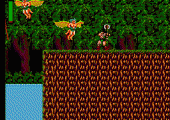
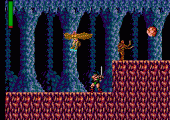
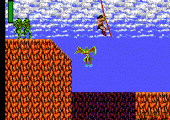
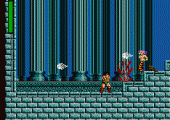
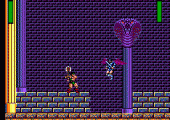
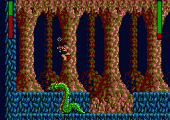
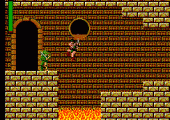
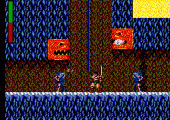
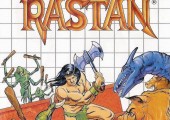
Recent Comments